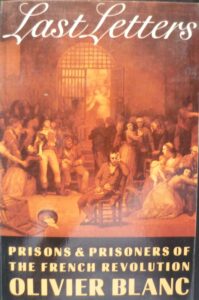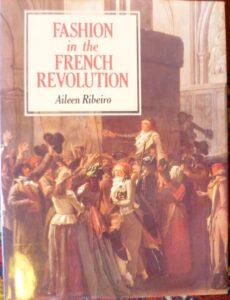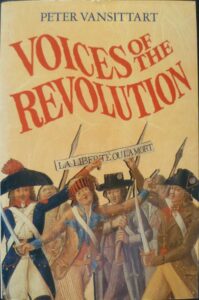The Cabochon Emerald, my 7th Elizabeth Hawksley historical novel, which comes out in e-books on Monday 2nd August, owes its existence to a lucky find in a second-hand bookshop: The French Exiles 1789-1815 by Margery Weiner. Weiner’s book absolutely grabbed me: she follows the lives of the some of the 25,000 émigrés who fled the French Revolution and came to England: who were they? Yes, there were aristocrats and members of the clergy (in 1793, the French Government abolished Christianity), but those fleeing for their lives also also included artisans who worked in luxury industries, like jewellers or couturiers, which made them more vulnerable to being arrested. Why did they choose to come to London – a Protestant country, after all; how did they get here; where did they live; and how did they manage to make a living?

The French Exiles 1789-1815 by Margery Weiner
Weiner’s fascinating book gave me the answers to this and much more: it also told me how the British government helped the émigrés: for example, John Wilmot’s Government Committee allowed penniless émigrés a shilling a day. The French themselves set up schools, hospitals and various charities.
Margery Weiner gave me the nitty-gritty – in wonderful detail. She named streets in Somers Town whose cheap houses were inhabited largely by French émigrés – I visited the houses, made notes and gradually found my way around the London they would have known; I saw the Catholic church they would have attended and so on. She also told me where they were buried, and what they did with their time. Some of them were penniless – the Comtesse de Saisseval, for example, learnt to make straw hats and sold them to help make ends meet. And bit by bit a story began to form in my head.
My heroine, Odile (or, maybe, Hélène, I hadn’t yet decided) is the spoilt 17-year-old daughter of a count, interested only in her début into society at Versailles the following year and in making a better marriage than her cousin Adélaïde. She looks down on Adélaïde who comes from a noblesse de robe (the nobility of the gown) family, whilst she, Odile/Hélène is from the noblesse d’épée, (the nobility of the sword) which is far more prestigious. Odile/ Hélène has much to learn – particularly when a nasty rumour turns up suggesting that she may be illegitimate.
She’s also a snob; she looks down on her father’s trusted clerk, Jérôme, a peasant by birth, who, unusually for that period, had a proper education, thanks to a sympathetic curé who wanted to give the bright young man a chance in life. When Odile/Hélène inadvertently gets caught up in the storming of the Bastille, it is Jérôme who rescues her. Unfortunately, at this point I hit a snag: The storming of the Bastille was in 1789 – I’d written a terrific scene where Jérôme drags a furious Odile/Hélène to safety – and I’d planned for her to escape the Terror by the skin of her teeth, thanks to the Jérôme’s quick wits – so that for the first quarter of the book, they thoroughly dislike each other.
Once in London, her father dies, and Odile/Hélène is forced to earn her own living for the first time – and things begin to change…
Alas, historically, the dates didn’t fit; the Terror itself – during which Odile/Hélène and Jérôme only just survive – didn’t start until September 1793 – a good four years later than the storming of the Bastille – what the hell could I do with a spoilt Odile/Hélène for four whole years! The story fell apart. And there was also a problem with such a – let’s face it – unpleasant heroine.
Furthermore, the intelligent reader will have picked up a further problem. Why on earth had I chosen names with so many accents! Hélène, Jérôme, not to mention Adélaïde! I’d lived in Paris during my late teenage years; I prided myself on my French; and I’d have died rather than remove the accents – which affects how the names are pronounced – so, all my main characters needed their names changing. I wasn’t yet prepared to admit it, but my story was a no-goer.

Last Letters: Prisons and Prisoners of the French Revolution by Olivier Blanc
One of the other French Revolution books I’d bought, Last Letters, is a compilation of the last letters written by prisoners to their loved ones shortly before their executions which, cruelly, never reached the intended recipients (the letters were confiscated as suspicious). They gave me a poignant glimpse into the minds of those facing imminent death. The book included a moving account by the Comtesse de Nicolaï whose mother had been imprisoned in the Carmes prison for women – once a Carmelite convent. As a child, the Comtesse had been allowed to visit her mother by a friendly gaoler, Roblâtre, in return for a bottle of wine.
Instantly, I had the opening for a completely different book. I could use this scene! My heroine, now called Anna de Cardonnel, is seven, the same age as Mme de Nicolaï had been but, instead of smuggling in letters and newspapers for her mother as Mme de Nicolaï had done, the heavily pregnant Comtesse de Cardonnel smuggled out the last of her jewels, the cabochon emerald, and hid it in a specially knitted pocket in the Revolutionary cockade Anna wore on her hat. The emerald would, the Comtesse hoped, pay for the passports that would get herself, Anna, and her husband the Comte (who was in hiding), out of Paris and to safety in London, and to arrange the bribe which would free the Comtesse herself – difficult but not impossible.
This brilliant book gave me horribly realistic, eye-witness accounts of how things were in those cold, dark prisons with their windows boarded up except for a foot or so at the top; the bravery of the prisoners, and first person accounts of how they felt – they hated being dirty, for example – but they couldn’t afford a bath – or to wash their clothes. The book also told me about other things, like the mouton (‘sheep’), ‘spy’ prisoners whose safety depended on them coaxing secrets out of the aristocratic prisoners. I hadn’t known about moutons before but, once I understood what they were, I found a ‘mouton‘ useful later, once Anna was in London.

Fashion in the French Revolution by Aileen Ribeiro
But my book needed far more than just knowing the dates of what happened when; readers would also be interested in what the characters wore and how female fashions changed from a 1786 pre-Revolutionary robe à la Turque in embroidered red satin, embellished with silk flowers and trimmed with ribbon, whose width forced the wearer to go sideways through doors. Clothes like this, and the astonishingly elaborate hats with huge ostrich feathers and large bows, expressed through fashion just how different the Ancien Régime was, and how little the nobility lived in the ‘real world’.
Aileen Ribiero’s book was brilliant at telling me what I wanted to know – like what would Anna have worn, age 7, to visit her mother in prison?
The white dotted muslin open robe and skirt and plain linen fichu worn by the Comtesse de la Châtre in 1789, only a few years later, shows a marked change from the former Ancien Régime formality. Politically, the Comtesse was a liberal and she had the good sense to leave quietly for England with her family when the Jacobins came to power in 1793 – and survived.

Voices of the Revolution by Peter Vansittart
Vansittart’s book is also a compilation of quotes by or about those involved in the Revolution, but its scope is wider; the subjects are not necessarily prisoners themselves. Here is Napoleon on the subject of Women. ‘We regard (women) as being almost equal to ourselves, a great error. Orientals are wiser and juster. They have pronounced females the natural property of males. And, in effect, Nature has made them our slaves. It is only because of masculine foolishness that they have dared claim equality. They abuse their rights in order to corrupt and dominate us.’
The French revolutionary, Olympe de Gouges, who fought for votes for women, ended up on the scaffold, as my heroine Anna well knew. Frenchwomen had to wait for the vote until after War II!
The book’s blurb describes Vansittart’s book as ‘constructed to read consecutively like the most exciting and passionate of novels.’ He brings the ‘massive revolutionary upheaval to life month by month, year by year.’ I found it both very readable and invaluable.
Whilst writing this blog, I realized that all the research I’d done on the French Revolution resulted in only two, fairly short scenes in Chapter 1 in my actual book. In the second scene, Anna’s mother died in childbirth in the Carmes prison infirmary, and her body, together with that of her still-born son was thrown into a unmarked grave and covered in quicklime. Shortly afterwards Anna, her father, and his mistress Madame Bonnieux, an excellent pâtissière, arrived in London and settled down in Phoenix Street, just off the Polygon in Somers Town, where Madame Bonnieux set up a successful Pâtisserie.
However, in spite of most of The Cabochon Emerald being set in London, my accumulated research somehow quietly infiltrated the entire book. The trauma of Anna’s childhood, the daily experience of smelling the blood in the Place de la Concorde after the guillotine had done its day’s work, left scars which affects Anna for much of the book. For example, her childhood spent climbing over the roof of the de Cardonnel chateau in Provence, helps her later escape when she is trapped by the villain in an attic room in the St Giles’s rookery.
She understands things she would have found it difficult to cope with had she not had those traumatic early experiences.
I’ve always liked stories where the hero and heroine come from completely different backgrounds, and The Cabochon Emerald’s hero, Luke, is a middle-class Commodities Merchant, living in Ludgate Street, almost opposite St Paul’s Cathedral. He has problems with women – his flighty fiancée was caught canoodling with his attractive but unscrupulous brother, Laurence – and he, Luke, needs to move on.
Laurence is only interested in money and, somehow, he gets wind of a possible stolen emerald and its rightful owner, a Miss de Cardonnel …
The story of the cabochon emerald, which Anna saw only once as a child shortly before her family’s escape from Paris, threatens to turn Anna’s life upside-down …
In spite of its bumpy kick-off, I thoroughly enjoyed writing The Cabochon Emerald and I hope that my readers will enjoy it, too.
© Elizabeth Hawksley
The Cabochon Emerald comes out in e-books on Monday, 2nd August
Please share this page...
What a fascinating period in history!
Revolutions rarely produce smooth transitions for the daily lives of most people.
You are quite right, Huon – in fact, I would say that Revolutions NEVER produce smooth transitions for the general populace! But it is also true to say that new ideas and new ways of doing things can also bring new opportunities for those who had previously been at the bottom of Society and had had few options in life.